Human Resources teams use Voice of the Employee as part of a data-driven approach towards improving productivity and reducing turnover by analyzing employee feedback at scale. This article explains Voice of the Employee is, how to use it in your HR team, and how to find the best Voice of Employee analytics tool for your organization.
Key take-aways
- HR teams are pivoting from recruitment to retention
- People Analytics brings a comprehensive approach to data analytics to HR organizations
- Voice of Employee (VoE) helps you understand what workers are talking about, how they feel and why they feel that way
- Choose a dedicated VoE tool that meets your power, scalability, privacy and support needs
Contents
- Background: HR Teams are Pivoting to Retention
- What is People Analytics?
- What is Voice of the Employee?
- How does Voice of Employee Work in Practice?
- Voice of Employee is Under-Utilized Because HR Teams Need to Break Free of Their Old Ways
- How to Make the Most of Your Voice of Employee Analytics
- Why You Need a Dedicated VoE Analytics Tool
- How to Choose a Voice of the Employee Tool for Your Organization
- Wrapping Up: How Lexalytics, an InMoment company, Uses NLP for Better VoE Analytics
- Further Reading and Resources
Background: HR Teams are Pivoting to Retention
Today’s workers are almost twice as likely to job-hop as previous generations. Why? Better benefits, compensation, workplace culture and opportunities for advancement.
Job-switching can be great for workers. But employers get stuck with the bill. Employee turnover costs 21% of salary or more, averaging $109,677 per employee according to Visier. And with 5.5 million Americans leaving their job in a given month, that money adds up fast.
That’s why companies are pivoting their HR policies from recruitment to retention. By uncovering the factors that cause employees to leave, these new-wave, data-driven HR organizations help their company avoid the costs and disruptions associated with staff transitions.
In addition, by understanding the factors that drive positive employee engagement, the same teams are improving their organization’s productivity and helping other teams identify how to better-train their staff.
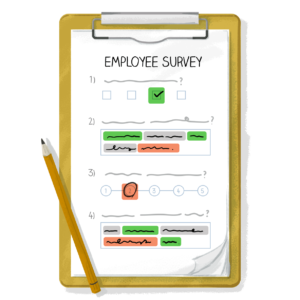
How are HR teams getting the data and insights they need to make these recommendations? Through People Analytics and Voice of Employee.
Let’s look at what these are, and how to use them to great effect.
What is People Analytics?
Where traditional HR data analytics programs were siloed and limited, People Analytics is a comprehensive approach to integrated data analytics. People Analytics uses statistics, surveys, demographics and other data to understand how employees think, feel and act. Human Resources teams use this data to make recommendations across the company to improve morale, retention, development and recruitment.
The result is improved corporate profitability through increased customer lifecycle value and reduced costs via better customer experiences and reduced employee turnover.
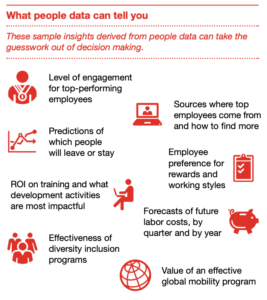
According to McKinsey, with People Analytics you can improve recruiting efficiency by 80%, improve productivity by 25%, and reduce attrition by 50%.
Among other functions, People Analytics gathers and analyzes employee data to discover trends and patterns in hiring and churn. But how can you reveal the causes of those trends?
With Voice of the Employee.
What is Voice of the Employee?
Voice of the Employee (VoE) measures employee experience and engagement. VoE reveals goals, concerns, pain points, perceptions and preferences using employee feedback from a variety of sources. Common Voice of Employee data sources include survey responses, Glassdoor reviews, social media comments, internal discussion threads and more.
Within the People Analytics framework, Voice of Employee focuses on turning text-based employee feedback sources into useful data and insights. But to hear true Voice of Employee, you need to go beyond quarterly employee surveys and performance reviews.
Why? Because structured surveys don’t give your employees the chance to voice their real feelings.
An employee with a survey can only answer the questions you ask them. That puts the onus on you to ask the right questions in the first place. And surveys only offer a snapshot of employee opinion at a specific point in time
In contrast, the best Voice of Employee programs are organic, unstructured and continuous. Workforce analysts use VoE analytics tools to process large volumes of text-based employee feedback, including reviews, comments, social media posts, Slack messages, and emails.
By analyzing a wide range of natural-language data sources, VoE shows how your employees think and feel, in their own words.
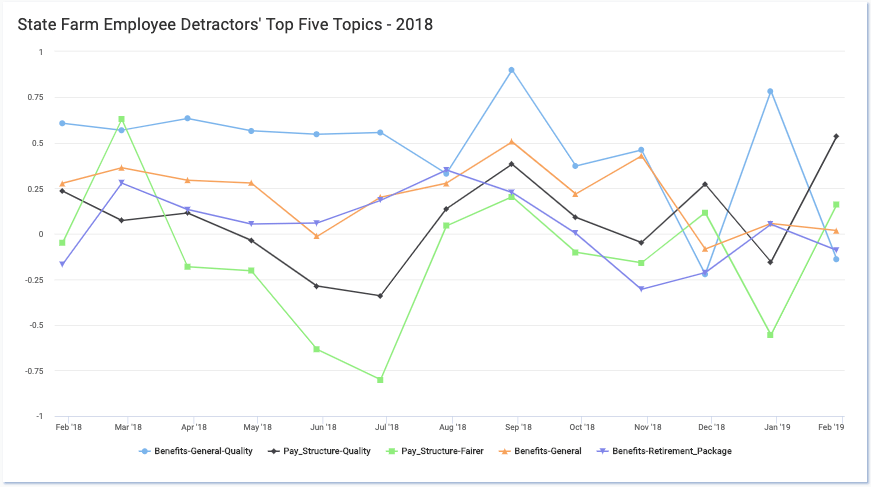
In a word, Voice of Employee is qualitative. It shows you “why” – an element that gets lost if you focus only on the “what” of quantitative data.
How Does Voice of the Employee Work in Practice?
For example, say you’re a Workforce Analyst at a big tech company.
Through People Analytics, you discover that your company is losing its top engineers at a rate that exceeds the industry average.
Then, through Voice of Employee, you reveal that they’re leaving because they can get more money at other companies.
Now, with data-driven conclusions and supporting evidence in hand, you can bring specific recommendations to your management team (for example, that your company re-work their compensation packages).
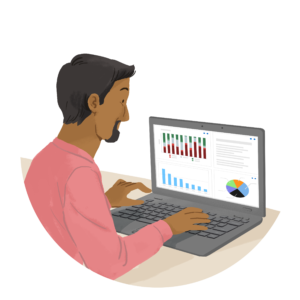
A couple more examples:
- If you learn which background factors correlate with sales performance, you can adjust your hiring criteria.
- If you know which managers deliver the best results, you can implement training programs to replicate their work styles.
Clearly, People Analytics and Voice of Employee are valuable for any HR organization. But both systems remain under-utilized, according to Deloitte.
Voice of Employee is Under-Utilized Because HR Teams Need to Break Free of Their Old Ways
Many organizations still rely on manual data entry and analysis. This makes employee feedback analytics prohibitively time-consuming and expensive.
In fact, only 8% of companies say that they have usable data. With siloed data sources and unscalable processes, it’s no wonder that People Analytics and VoE adoption is low.
What’s more, manual survey coding can easily miss hidden meaning and themes. It’s difficult for a human to overlook patterns or trends in big data sets. And manual analysis is often limited to in-house data and communications. This means that you’re forced to ignore valuable data from job boards, review sites like Glassdoor, and social media platforms.
Data Analytics Tools Can Help You Hear and Understand True Voice of Employee
Fortunately, natural language processing (NLP) shines where manual processing falls short. Using an NLP-powered VoE analytics tool, you can analyze in minutes the same data that you might have spent months poring over – or ignored entirely. This lets you bring in more data sources, improving your ability to hear and understand how employees feel.

VoE tools like Lexalytics Spotlight show you who’s talking, what they’re talking about and how people feel about those subjects. HR teams use these tools make better decisions around compensation, training, work environments and more. For a full VoE analytics demo, check out our step-by-step VoE analytics guide.
How to Use Voice of Employee Analytics in Human Resources
Recruitment
Classify and rank candidates, identify and match (un)desirable traits, and filter out known biases.
Feedback
Use sentiment analysis to identify specific issues as well as patterns and trends over time.
Succession planning
Identify potential leaders and their needs to fit them to roles or develop career pathways.
Appraisal and retention
Keep an eye on approval ratings, comments, competencies and goals to appraise staff and identify attrition risks.
Social media analysis
Monitor employee behavior, competence, interests and perception to identify issues or opportunities.
Underpinned by computational linguistics, NLP-powered VoE tools take Human Resources teams far beyond the Boolean searches of old.
Why You Need a Dedicated VoE Analytics Tool
It’s clear why manual Voice of Employee analytics is a non-starter. But why not use the limited text analytics capabilities in your current business intelligence tool to process employee feedback?
It’s simple: Unlike general-purpose business intelligence tools, dedicated Voice of Employee tools are specifically built to tackle the challenges involved in analyzing text data.
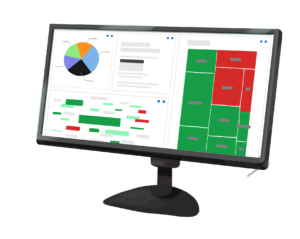
Compared with manual analysis or general-purpose business intelligence tools, VoE solutions…
- …are faster, cheaper and infinitely scalable
- …can consolidate multiple data sources into a single platform
- …are already configured to understand natural employee language
Ultimately, a purpose-built Voice of Employee analytics tool simplifies your People Analytics while delivering better results.
How to Choose a Voice of the Employee Tool for Your Organization
If you’re in the market for a VoE tool, you have many options to choose from. MeaningCloud, Confirmit, Verint and Lexalytics all offer suitable products. How should you choose?
We suggest you balance these 4 factors:
Factor 1: Power
Look and feel aren’t everything. Some Voice of Employee tools only offer basic document-level text analytics from limited data source. These systems may give you an overall sentiment score for an employee’s survey response. But they won’t be able to show you why they feel that way.
In contrast, specialized VoE systems use complex NLP functions like multi-layered sentiment analysis to produce precise, useful insights into what employees are talking about, how they feel about those subjects, and why they feel that way.
Factor 2: Scalability
As your organization grows, so will your data analysis needs. But that doesn’t mean you should go out and purchase a giant system to grow into. Likewise, you shouldn’t have to buy a fixed-size solution that you know you’ll need to replace. You need a solution that scales with you.
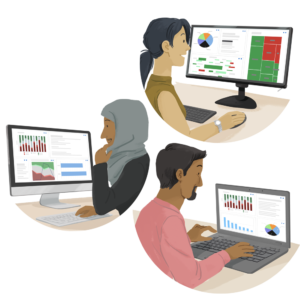
For cost, data storage and data processing reasons, choose a VoE tool that is efficient and adaptable. If your data processing needs peak at certain times of year, or you’re running a one-off campaign, your solution should adapt accordingly. The best VoE analytics tools can scale up, down and across various instances with little additional workload.
Factor 3: Privacy and security
More data is falling under regulatory review and strict privacy requirements. Your system needs to safely store your data, and strip or encrypt sensitive or identifying information.
Most VoE solutions offer end-to-end encryption of data. Some tools even offer flexible deployment models, including on-premise, private cloud or hybrid cloud infrastructure. So, don’t settle until you find a system that meets your privacy and security needs.
Factor 4: Support
Any business intelligence tool gets better when you customize it. This is especially true for systems based on text analytics and natural language processing. For best results, you’ll want to tune the NLP features to understand the language of your industry, create custom topic taxonomies, or even train machine learning micromodels to handle tricky, ambiguous words and phrases.
But setting up, tuning and training a VoE analytics tool can be challenging for non-technical analyst teams. That’s why you should choose a vendor that offers (without prompting) to custom-fit their solution to meet your exact analytical, security and scalability requirements.
Wrapping Up: How to Use Natural Language Processing to Hear the True Voice of Employee
Behind every employee is a story. But static surveys and performance reviews don’t tell you have employees really feel. Integrating a Voice of Employee analytic solution like the Lexalytics Intelligence Platform into your People Analytics program helps you hear, understand and share employee stories. The insights you gain will directly help you improve customer lifecycle value through more-engaged employees, while reducing the fiscal and productivity costs of employee attrition.
With Lexalytics for Voice of the Employee, for example, you can reduce turnover, identify cultural issues, engender loyalty, improve hiring processes and pinpoint successful approaches to replicate. And we make it easy to extend your workforce analytics program to help other teams, such as finance and operations, by sharing insights and recommendations.
For more information, read our solution profile: Lexalytics for People Analytics and Voice of Employee
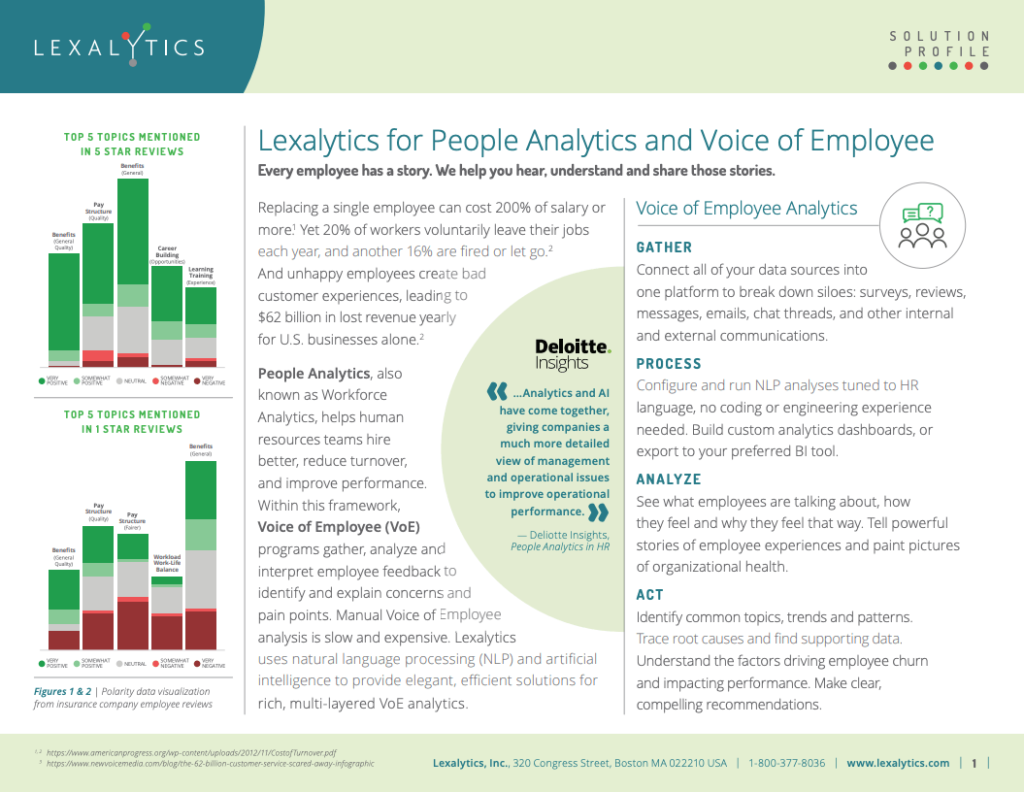
Not looking to buy a Voice of Employee analytics solution?
Further Reading and Resources
Not looking to buy a Voice of Employee analytics solution? Here are some resources we found in our research that we recommend for anyone interested in learning more about People Analytics and Voice of the Employee:
Analytics in HR: How Natural Language Processing can revolutionize human resources
Deloitte: People Analytics: Recalculating the Route
McKinsey: People Analytics: Advanced analytics for better talent and business decisions
Harvard Business Review: Better People Analytics
Or, if you’re on the fence, don’t hesitate to get in touch. We work with companies of all sizes across all industries to use text analytics to deliver insights into the employee experience. We’ll be happy to offer our perspective on how you can improve your People Analytics program.